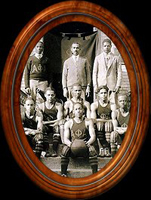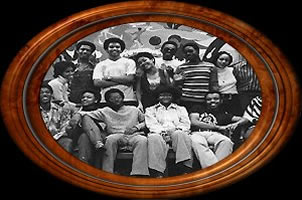| +
ivy league memoir. a family legacy
 
black student retention
in the ivy league
As
a youngster, I used to listen to my mother tell me how she and
her sister grew up in Ithaca, New York.
She
was always talking about how pretty it was and would go on and
on about the Finger Lakes and
the
mountains. It always seemed weird to me since I grew up
in the segregated south. I knew about New
York
City (I thought that Harlem was the same as New York back then)
and Brooklyn because I had heard that
a
lot of Black folks lived there. Back then I figured that
Black folks could not possibly live in places like that,
living
that close to white people and such. On top of that it was
too cold. Coming from Richmond, Virginia
this
all seemed too strange for me. I could not really understand
how Black folk could live that close to
white
people.
As
my mother told me more, I learned that my grandfather, who died
before I was born, won a scholarship
to
Cornell University
back in the early 1900s. He stayed up there and married
a beautiful woman whose
family
was one of the few Black families in town. That was why
my mother, the older of two sisters, was
born
there in what I thought was a strange, far-away land. And though
she is dead now, the romantic visions
of
this cold life in a small quaint college town remain imbued within
me.
Her
father faced many challenges as one of the very few Black students
at Cornell during that time.
Basically,
all of the other Black students shared those challenges as well.
I learned that he bonded
with
a number of them and decided to start a Greek Letter fraternity.
It seems at that time there were
no
fraternities for Black students and assimilation into University
life at Cornell was difficult. More than
the
weather up there was cold.
Anyway,
my grandfather and six of his fellow students were successful
in founding the first Greek
Letter
Fraternity, Alpha Phi Alpha in 1906. Back then Cornell was
daunting; though admitted to study, it
was
clear that students of color did not really belong or feel welcome
in the community. At the same time
Greek
Letter Fraternities were a key survival system for white men.
They provided social bonding and
academic
support for their members. Logically enough, Blacks could
not join them back then. What
my
grandfather and his friends, now affectionately and reverently
known as the founding Jewels of Alpha
Phi
Alpha, did must have been phenomenal. They were courageous
enough to say that if we cannot join
the
fraternities that make you feel welcome and supported at Cornell,
then we need to form our own. There
had
been an earlier effort to start a fraternity at Cornell for Black
students that was unsuccessful, but
my
grandfather and his friends were committed enough to make their
goal a reality regardless of the sacrifice.
Alpha
Phi Alpha now has members worldwide and boasts in its membership
so many accomplished
Black
men that it has truly set a proud tradition. There is so
much good that can be said for the organization
that
this article certainly cannot do it justice. If any readers
want to know more I would invite them to visit
the
Alpha Phi Alpha website, www.alphaphialpha.net.
In
a twist of fate my grandfather seemed to have deeply influenced
my fate when my opportunity to
attend
college came. Oddly enough, Virginia's resistance to integration
gave me a strange break. The
state
started to close schools and actually would pay for students to
go to private schools out of
state.
Ostensibly this was to help white students avoid the apparent
curse of studying alongside Black folk.
My
mother insisted that I apply to private schools and encouraged
me to target New England boarding
schools
in particular. Through this twist of fate, I earned a
scholarship to the Phillips Exeter
Academy and
got
additional aid from the state of Virginia so that it cost my
family very little for me to study there.
While
Exeter was largely a culture shock for me, I survived and learned
that smart and good people can
come
from anywhere and any background. I got a good education
and for the first time in my life learned to
live
alongside whites, both rich and poor. It was academically challenging
for me as a teenager from the
South
but I survived. By the time I was ready to graduate, my
mother was quite ill and was pleading with me
to
target an Ivy League institution. Again I heeded her pleading
but rebelled against the idea of Harvard.
Too
many of my classmates were desperate; it seemed, for that chance.
I was more influenced by a chance
to
get to a big city and found out that Columbia was in New York
City and the University of Pennsylvania was
in
Philly. My idea of going to college was having the chance
to hear live jazz and be bop in particular. Philly
and
New York were it for me. Fortunately, I got accepted to
both. My mother thought New
York was too much
for
me. Without comment here, she obviously did not understand
how Philly really
was. But on the basis of
her
opinion I chose Penn.
Roll
forward from Cornell in the early 1900s to Penn in the intense
and radical sixties. I found out that not
a
whole lot had changed. There still were not that many Black
students attending Ivy League universities
in
general and Penn in particular. You could walk around all
day and not really see any. If you did it was
no
more than one or two. I was blessed to have a Black roommate
who was also my Exeter classmate
and
one of my closest friends. I set up my own support system
before I got there.
However,
I quickly learned that we had gained admission but had not gained
acceptance. Generally I found
that
those Blacks who played varsity sports had a little more chance
to get some level of acceptance based
on
their athletic value and charisma. I also found out that
among the few Blacks there, a number of them
came
with high test scores but didn't have the same level of preparation
that I did. By my sophomore year
I
noticed a lot of them were flunking out. They were often super
bright, by any criteria, but they could not find
any
sense that they were welcome in such an academically challenging
environment.
By
my junior year, I had met as many Black students as I could.
My southern upbringing and
outgoing
personality made me want to speak to every Black student that
would speak back. I met a young
man
who had come down from Harvard to study law. He told some
of us that Harvard had underground
groups
for Black students and that we should start one at Penn.
We agreed and gathered in front of the
library
where he staged a speech. After listening to him speak I
decided that I disagreed with him because
his
emphasis was on helping less fortunate people outside of the University
instead of the students within
the
university.
My
contention was that too many of the students at Penn were having
a hard time academically. It was not
that
they were not smart enough or unwilling to work hard enough but
that they just did not feel that it was
really
their school. I argued that many of us just felt depressed
and rejected at the University on a
community
level and it made it that much more difficult to deal with what
was already hard. Well, the
law
student from Harvard quietly backed down and gave me the mike.
Sometimes in retrospect I think he
set
me up to do what I did. He may have been reading some Machiavelli
or something.
Anyway,
from my speech, the small group of students gathered anointed
me to start a group. A student
from
West Africa agreed to serve as Vice Chairman. Our purpose
was sort of primal. We formed
the
organization to help ourselves survive and graduate. Some
resented that and viewed us as privileged
but
did not understand how vulnerable we were and how dispensable
we felt. Radicals invaded campus
when
we had meetings and tried to make us feel guilty. Despite
this, we formed a group called the Society
of
African and African-American Students otherwise known as SAAS.
It survived. It was a sixties solution to
the
same problem I imagined and still imagine that my grandfather
and his friends had at Cornell.
The
formation of the group caused me some problems with the establishment
at Penn but I survived
the
turbulent times and graduated. This is ancient history now
but Penn has grown to embrace Blacks
more
aggressively than many schools now and SAAS evolved to become
the Black Student League.
Not
entirely like Alpha Phi Alpha, but in my own small way, I along
with my fellow students who were
members
of SAAS worked to keep the flame alive. Let us not see bright
minds in people of
color
underdeveloped, destroyed or embittered.
I
feel a psychic connection to a grandfather whom I never met.
I am grateful for his legacy and gift to me.
I
hope this story helps us remember that we must remain vigilant
and that those who came before us in
the
struggle for rights and opportunities made it possible for us
to have even higher expectations and
greater
opportunities in the face of challenges.
My
own thinking is that we should not rest too long to revel in the
petty pleasures of luxury and success
that
“integration” and equal opportunity has brought us
largely on the backs of our ancestors. We must
commit
to make sure that those students of color who are in higher education
not only survive but excel.
We
must help and encourage every student who wants to go to college
to find a way to do so. Whether
Ivy
League or not, Historically Black Colleges and Universities or
not, we need to stay committed to
young
people of color and build on the positive legacy.
Washington
DC based Julian Conway Wilson Jr.
is
an educator and the
grandson of Robert Harold Ogle, one
of the seven Jewels who founded Alpha Phi Alpha Fraternity, Inc.
He is currently working on a book project about estranged fathers
and family healing. |